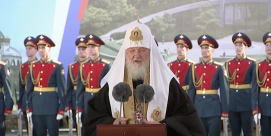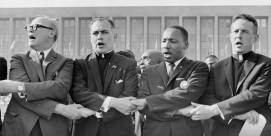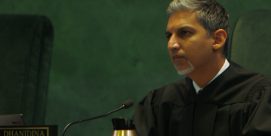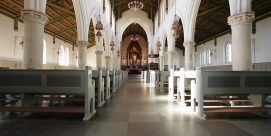In This Episode << SLIDE LEFT TO SEE ADDITIONAL SEGMENTS
Friar Gilberto Cavazos Gonzalez on Hispanic Catholics
Read more of Judy Valente’s interview about Hispanic Catholics with Friar Gilberto Cavazos Gonzalez, who directs the Hispanic ministry program at the Catholic Theological Union in Chicago:
Q: How would you characterize the Hispanic Catholic community in Chicago?
A: Large and growing. It’s been here for a long time. Apparently, the first Hispanic community came in the 1920s already. A number of the migrations came with Latinos, or Mexican Americans and Puerto Ricans and others following the migration patterns as far as migrant work, near the Chicago area. And eventually, after a few summers of coming up, staying up here, in the ’80s it got a large influx from Central America, because of the political turmoil that was going on in Central America. Before that there was a large influx of Puerto Ricans, and originally Mexican Americans and Mexicans. But it’s very diverse, and when we talk about “Hispanic” or “serving the Hispanic church,” many times we have to ask, which one? You know, are we dealing with Puerto Ricans? Are we dealing with Mexicans? Are we dealing with Mexican Americans? Are we dealing with, you know, first generation? Are we dealing with a generation and a half? Are we dealing with the second generation and other generations? I believe that if people came in the ’20s, you could already have fifth and sixth generation Hispanics in Chicago.
Q: What about the numbers? What are they now, and where do you see them going in the next 20 years?
A: I know that — numbers I’m not very good at. I do know that in the last census, the Hispanic population in Chicago was on par with the African American population in Chicago. It might have even actually been like .01 percent more. And the projection at that time in 2000 was that in the next ten years the Hispanic population was going to be growing by about 53 percent. We’re already in year seven of the next ten-year projection. [In the church] I don’t think we will be the dominant group. We will still be a minority, unfortunately. You know, the majority number-wise doesn’t always make you the majority politically or as far as ecclesial power is concerned.
Q: Why would that be?
A: Historically there’s a lot of reasons for it. When the United States conquered the southwest and took Texas and California and all of those, you know, whether they bought it or took it, whatever, it doesn’t matter, and they took possession of the land, the U.S. church moves in and finds a Hispanic church that has been present in the area, you know, for way over 100 years, that had already been present in America since the 1500s. And it was a church that was established with a much more medieval mindset, a mindset of the presence of God everywhere, the presence of God in the cotidiano or the day-to-day routine of life. And the U.S. church that’s moving in is an Enlightenment church that is more rational. The Hispanic church that was present was more emotional. The church of the 1500s saw the natives as human beings with souls to be saved. The church of the 1700s and 1800s wasn’t too sure. And so they came in and basically said, well, if we’re not sure if the native, you know, or the half breed or the mestizo has a soul, should we be ordaining them? And so they closed down the seminaries. That was over 150 years ago. But as we know with church history, what you do in one century will have repercussions into the next few centuries. So we’re still feeling that. It wasn’t until the 1950s that Hispanics were welcomed into U.S. seminaries. Patricio Flores, the former archbishop of San Antonio, was one of the first ones. He was also the first Hispanic bishop. But then when you look at the numbers percentage-wise, we are almost 50 percent of the U.S. Catholic Church, and our clergy is under six percent Hispanic. Our religious as well. Our bishops even less. I believe there’s only like 14 or 15 Hispanic bishops in the United States, so representation is not there.
Q: Let’s talk a little bit about Hispanic worship. What are the most fundamental ways Hispanic Catholics are changing the American church?
A: Well, I think fundamentally what we have to offer the U.S. Catholic church is certainly the recognition of the presence of God in day-to-day life, in what we call the cotidiano, the everyday, day-in, routine, humdrum of life, and that somehow God is present in all of that. That’s one thing. Devotional life is another thing that we have to offer. It’s interesting to me to go to different websites of different parishes where there are not that many Latinos, and yet they’re doing, you know, celebrating Our Lady of Guadalupe, celebrating the, you know, the posadas, the Christmas novena, living stations of the cross, which are all traditionally coming out of Latin America. And, you know, we’re contributing to the church by and through Latin America. Strangely enough, Latinos in general have a deep desire to understand the sacred scripture, and sometimes some people think that, you know, those who are into devotional practices aren’t really into reading the scripture and vice versa. And yet since the 1960s and the ’70s, especially with the charismatic movement and the birth of the, you know, home-base communities in Latin America that have then moved into the United States, there’s this desire and this longing to really tap into what are the gospels saying? Not what are they saying as far as hermeneutics and historical criticism and, you know — that’s all nice stuff, but what are they saying for my life? What are they saying for the day-to-day, you know, or the cotidiano of our nation, of our church, of our community? That’s one thing I think that we are beginning to see in different U.S. parishes, is that some of the models of how to do scripture study for daily practice that are coming out of Mexico are making an impact in the U.S. church as well.
Q: How is it different from how US Americans in general worship and practice their faith?
A: I think basically it is different in that we were — neglected is a harsh word, but in many ways we were neglected by the U.S. Catholic church for over 100 years, relegated to the back pews, etc., and as a result we have had to nurture our own faith, our own religion, our own church, and those who have nurtured it [are] primarily women: our mothers, our abuelitas or our grandmothers, our tias — our aunts. Sometimes also the abuelos, the grandfather, or a male wisdom figure as well. And so as a result, we have a high respect for the clergy, but we know that we can live without them. We know that we can be church, you know, with or without the clergy and that somehow we have endured as church oftentimes without the clergy. Probably in a church that is facing a great priest shortage, this is a good message. This is something that we need to hear, that, you know, the Hispanics are known for our love and respect of the clergy, and often because we never really had them around, and yet at the same time we also know from our experience that, you know, it’s wonderful to have a priest and it’s wonderful to have Mass. But if we have to, we figure out other ways of worship in order to remain Catholic.
Q: Is that what you’ve meant in the past about the ambivalence toward clergy in the Hispanic community?
A: Yeah. I come from a, believe it or not, I come from a very anticlerical family. My grandmother told me she loved me despite the fact that I had become a priest, you know, and for many, many different reasons Mexicans have historically, you know, both loved and hated the clergy or the hierarchical church. Our Catholic religion was founded by the European church and by the European missionaries and the European hierarchies, particularly the Spanish and the Portuguese, and so we owe a great debt of gratitude to that church. At the same time that we were being evangelized by dedicated men and women religious, we were also being conquered and violated by Christian soldiers, and so already there is that ambivalence that was built into the way we were evangelized. At least we weren’t being killed off like the Native Americans with the Protestant churches. But it was still a violent evangelization. The father of our country or the George Washington of Mexico is a priest. He was a diocesan priest. A lot of the first generals in the Mexican revolution were priests, and so, again, the church is there at the forefront of our liberation. As time goes on, then the church becomes part and parcel of the government and part and parcel of the problem, and so you get, then, you know, in the early 1900s, more revolutions for equality and liberation and justice, and one of the entities that had suffered for it was the church, partially because the hierarchy was part of the problem, and partially because there was persecution.
Q: You mentioned the role of women in passing on the faith. What do you think the role of women would be in a majority Hispanic Catholic church in America?
A: That’s a hard question. From my experience when I was in the parish, I know that I could always count on the women lay ministers. If I needed help with, you know, running the baptismal classes, if I needed help with, you know, running wake services, I could always count on the women lay ministers. Is that servitude? Is that, you know, a priest taking advantage of the women? You know, I suppose some people would say yes — and some people would say no. Is that, you know, the priest or the pastor having women participate in the general ministry of the church? Again, some people would say yes, some people would say no. But that was the reality, and I think that’s the reality in a lot of our parishes — that our pastors pretty much know there are a lot of women lay ministers that we can count on, hopefully in a spirit of, you know, working together or, you know, what we call en con junto — everybody doing their part for putting together this ensemble of ministers. At the same time, the slew of women ministers in our churches, then, has had the effect of somehow pushing away the men, you know, or the non-ordained male. And so in Hispanic culture, in Latin America in general, you know, the feeling is the church is the domain of women and priests and for the most part [they] can’t figure out what the priest is doing there to begin with, because the church, you know — religion is women’s domain. Some men will not feel the need to participate in church because that’s women’s work. Other men will simply feel relegated or pushed out because the women are in control of the ministry, which is strange to say in the United States, because I know that there is justly a woman’s movement in the church that says, you know, women, for the most part, are not allowed in church hierarchy. And, again, that goes back to the whole question of just because you’re the majority doesn’t mean that you are the dominant factor. You know, there are a lot of women religious and a lot of women lay ministers, but when you come right down to who’s in control it is, you know, ordained men.
Q: Has anyone reacted negatively in the U.S. Catholic Church to the Hispanic influence and impact?
A: There’s negative, and there’s negative. We’re too Christian to show our bias openly, and so we do it, you know, in hidden ways or in subtle ways. I would hope that people who go to mass, you know, on a regular basis, who consider themselves good Christians wouldn’t openly reject anybody coming through the doors of the church. So I don’t think there is much of an open rejection of the Hispanics in the church. And yet at the same time I have heard — men and women who are in positions of power in different dioceses around the United States talk about well, you know, when we raise the question of, you know, should young men and young women training for church ministry be learning Spanish, for example. I’ve gotten the response from different people that will say the next generation isn’t going to speak Spanish, so why should I bother learning it? That’s a subtle form of rejection. The choosing, for example, of foreign-born Latinos for positions of power in the church, be it bishops or be it the head of a certain office, when you could just as easily choose a native-born Latino is also another form of rejection. You know, it’s easier to deal with the foreign-born Latino oftentimes than it is with the native-born Latino for a variety of reasons. That you would relegate the Spanish mass to certain times of the day which are the off-times, you know, not the peak hours, is another way of rejection. These are subtle ways of rejecting or keeping the Latino church at bay rather than using — I know of churches that rather than allowing the Latinos to have mass in the church, because we bring children to mass, we get relegated to the basement or the gym. So I don’t think that anybody would openly reject the Latino in the U.S. church, but there are ways in which — I don’t think it’s outright rejection. It’s just lack of hospitality.
Q: Why is it so difficult to integrate the Hispanic community with the Anglo community or the African American community on a parish level? Often you do see the separate mass, and Hispanics will want the separate mass in Spanish.
A: I don’t think that “separate” means “not a part of.” I believe that you can have a mass in English. You can have a mass in Spanish. You can have a bilingual mass. I don’t know of any Catholic church in the United States where all the parishioners come to the same mass on Sunday, unless it’s a very, very small church, and so you will always have a number of masses offered on a given Sunday. That doesn’t mean that the people at the 10:00 mass never talk to the people at the 12:00 mass or that they’re not the same parish.
Q: But so often that happens.
A: I love to pray in Spanish, you know. It took me a while before I realized that God understands English, and I think that people like to pray in the language that they’re comfortable in. I think that people like to pray in the language of their heart. I know I preach better in Spanish than I do in English, and I pray better. When I’m praying over people, you know, I can feel the prayer better in Spanish than I can in English, again, because Spanish is the language of my heart. Does it mean that because I prefer to pray in Spanish I’m not a part of my community? I don’t think so. It means I’m a part of my community, and it means that, hey, every once in a while I need a fix. I need to pray in my own language, in my own tongue. I think that in the U.S., it’s not just — I mean Hispanics probably are the ones who are showing the reality of the U.S. church to the U.S. church itself. A lot of times what happens is you get so used to your own reality that it’s not until you are faced with the significant other, you know, that all of a sudden you realize things about yourself. I always knew I was Mexican American — didn’t really realize it until I came to the Midwest where all of a sudden I’m in a culture that’s completely different than my own. I think that when Hispanics are moving into these parishes, the U.S. church is beginning to realize that, hey, there is no such thing as a U.S. culture or Anglo culture. All of our parishes are culturally diverse. There is a diversity in generational cultures. There is a diversity in economic cultures. All of a sudden we are being faced with, you know, what some people like to call multicultural churches, or I prefer culturally diverse churches, where there’s all sort of cultures going on within the same church, and yet somehow we’re called to get along with each other and not to have one culture dominate another culture.
Q: Is there some aspect of what Hispanics bring to the Catholic Church in America that might be perceived as negative?
A: No. I mean I would imagine that there are some people who would perceive different cultural nuances as negative. I don’t think there is a Catholic culture, you know. I don’t think Latinos are more Catholic than U.S. Americans. I don’t think Italians are more Catholic than the rest of the world — you know, or Polish, or whatever. I believe every culture has the seeds of the gospel, and every culture has things that the gospel needs to challenge. We are accused of being male-dominated, and to a certain extent we are. And yet at the same time we’re a very matriarchal society, or matriarchal culture. Do those things — do those two realities enter into conflict with each other? Yes, they do. Do those two realities need to challenge each other? Yes, they do. There are many Hispanic men who are here alone because they’re here to — you know, like my father came here to work for money to send back home to take care of the wife and the children. That’s unfortunately a part of the immigrant culture, whether it’s Hispanic, or German, or Polish, or whatever other people are migrating here for a better life. A lot of times the men come here and leave the family at home in order to send money home. Is that a problem? Yes, that’s a problem. It’s a problem here, and it’s a problem back home. And so sometimes the problems are not necessarily cultural problems. The problems are economic problems. The problems are social problems. The problems are caused a lot of times by bad governments in Latin America, a lot of times by U.S. enterprise interfering in Latin America and other parts of the world.
Q: I’d like to ask you about Hispanics and the social changes they are bringing to the church, changing positions of the church, and whether or not you think they are more socially conservative than Americans in general?
A: The Roman Catholic Church in general has been, since the late 1800s, the leading Christian community as far as social change and social documents. Many of the other Christian communities look to us to sort of lead the way on social issues and social concerns. The Latin American church took Vatican II very seriously.
Q: I mean specifically Hispanics in America.
A: Right, well, I guess I’m setting the stage that that’s where we come from as Hispanics in this country. We come from the church of the 20th century that, you know, pushed for lay apostolic movements that were centered around social issues and social concerns. We come here believing that the church is no longer a church that sides with the rich, but rather a church that has a preferential option for the poor. We believe that firmly, and so because we believe that firmly, we expect that the hierarchy of the church is going to advocate for the poor, for the marginalized, for the outcast. And right now a lot of the poor, the marginalized, and the outcast are us, are the Hispanics, especially the Hispanic immigrants. So, one, we expect it. We expect it from our clergy. We expect it from our bishops. We expect it from each other. So I believe that the Hispanic presence in the U.S. Catholic Church is challenging the U.S. Catholic Church to be more faithful to what we as a church universal say that we believe, and that is social justice. You know, if we want peace, we have to work for justice, to quote Paul VI.
Q: Do you think Hispanics have influenced the church’s position on immigration, on economic issues?
A: I think so. I would like to think that the hierarchy writes it documents because it looks at the people around them and deals with the people around them. I don’t think that the bishops are going to make statements on immigration without somehow consulting the Hispanic community, which is right now at the forefront of immigration issues in the United States. The economic issues are very, very complex, and I’m not really all that familiar with them. I am more concerned right now with immigration.
Q: What about the face of the Catholic Church in 20 years? How do you see things shaping up?
A: In 20 years? It’s a long time, and it’s not a long time, is it? The largest Catholic population in the United States is Latino. The youngest Catholic population in the United States is Latino. The fastest growing population in the United States is Latino. In 20 years time if I could dream, you know, I’d like to see over 50 percent of the U.S. Catholic bishops being Latino, 50 percent of the religious and the clergy being Latino. Some of them may be even married, you never know, or women.
Q: How likely is that?
A: How likely is that? Well, the spirit works in many, many different ways. The face of the clergy and the face of the church has changed a lot in 2000 years. You know, we used to have a Jewish face, then we had a Greek face, and we’ve had a Roman face for a long time. I don’t think we’ll ever have a Latino face. I’d like to think that we will have a culturally diverse face, and that in 20 years time there will be a growth of Latino membership in the hierarchical structures of the church, and of African American and Asian American. I’d like to see a church that is increasingly culturally diverse, and yet united.
Q: How concerned are you about the exodus of Latinos to evangelical churches?
A: The theologian in me is not that concerned, because the spirit needs to do what the spirit needs to do. The Mexican American [in me] is pretty concerned. We were founded by the Holy Spirit, you know, 2000 years ago. When we came to America 500 years ago, the friars that came all came as, you know, spiritual men who really believed and pushed the power of the Holy Spirit. The charismatic movement has opened us again to the movement of the Holy Spirit, and ultimately we need to go where the spirit takes us. And if the U.S. hierarchy is not going to meet our needs and the Pentecostal churches are willing to, then that’s where we need to go. I would like to think that the hierarchy of the church loves us and wants us to remain Catholic. But they have to be more hospitable to us.
Q: Would it mean having more services that reflect the Hispanic culture? Growing a group of Hispanic American priests?
A: I think it means conversation and dialogue. There are a number of wonderful non-Hispanic men and women religious and lay ministers and priests who have served our church well, and the one thing that they have in common is they like to ask questions, and they actually listen and wait for answers. It’d be great to have all sorts of Latinos in religious life and in the priesthood, but that is going to take time. And in the meantime, the ministers who are going to serve us are going to be non-Latinos, and I think that they need to be men and women of conversation and dialogue, and we don’t always get that. But that’s what we need.
Q: What do you think are the most profound changes happening in the Catholic Church for Hispanics?
A: When I was growing up, we took it for granted if you were Hispanic or Latino, you were Catholic. If you were not, you were Protestant. It wasn’t until I went to high school that I realized that there was an Anglo-Catholic church and that they made the sign of the cross. They didn’t kiss their fingers like we do, but they made the sign of the cross, and they went to confession, and it was shocking. It was eye opening. I would like to think that somewhere on the other side of the country at the same time that I was learning that there were, you know, Anglo Catholics, that there was an Anglo Catholic learning that there were Latino Catholics, and that it was shocking and it was eye opening, and yet enriching. I think that the most profound change that we are making in the U.S. Catholic Church today is that we are awakening the U.S. Catholic Church to the realization that it is one part of a church that is so much larger than itself, and a church that is culturally diverse, and that that’s shocking, and it’s eye opening, and it’s enriching, and I do believe, you know, I mean, I hear it here. I hear it from the lay ministers who are coming to school here and who are asking questions about, you know, how to better serve the Hispanic. And one of the things that they’re realizing in our courses and in our classes and in our conversations is that the U.S. church is so much bigger than their own little parishes. And for them and for myself that’s exciting news, because it does really, really open us up to a worldwide universal church, which is the church that we really belong to. And sometimes we forget. We get so caught up in our own local concerns.







